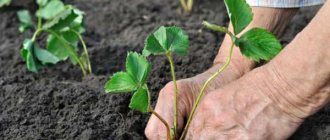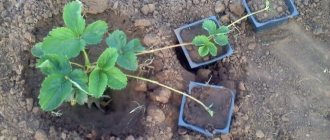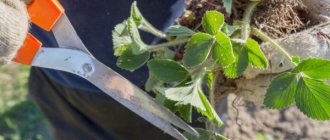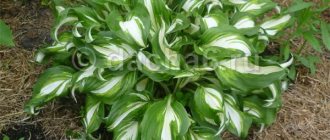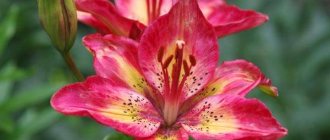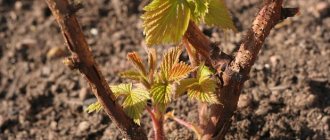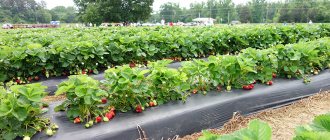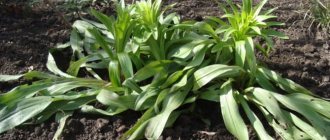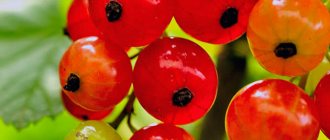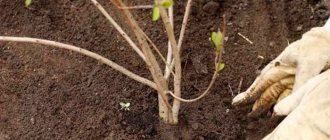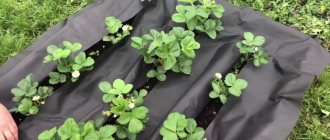If you want to update your strawberry beds or are planting berries on your plot for the first time, then it is better to do this in August.
Dear readers!
For you, we have created communities on social networks in which useful articles and interesting ideas are published several times a day! Subscribe and receive useful content in a convenient format! In today's article we will look at the main features of planting strawberries in the last summer month and some of the nuances of the procedure itself.
What are the features of planting strawberries in August?
The optimal conditions for planting strawberry rosettes in August are a decrease in daytime temperature to 20-25 degrees and air humidity of at least 70%.
Strawberries planted at this time do not require special care. It is only important to water it and not allow the soil to dry out. You also need to mulch the planting.
There is also no need to feed strawberries after planting. All fertilizers must be applied to the soil when preparing the beds.
There is also a nuance. Do not add too much nitrogen fertilizer, as this can provoke abundant growth of green mass. Before winter, this is bad, as frost can destroy the plants.
The advantage of August planting is obvious. The bushes have time to take root and take root in a new place. After wintering, they actively grow and in the spring they can bloom and bear fruit. Unlike plants planted in spring.
Strawberry processing
In order for all the ovaries that have formed on the bushes to survive until the autumn period and delight them with juicy fruits, it is necessary to systematically care for strawberries throughout the entire growing season. Namely, destroy dried leaves and mustaches.
Mustache trimming
The bushes periodically throw out tendrils, which take away a large amount of useful substances from the ripe berries. They should be trimmed in the summer using scissors or pruning shears.
If you want to increase the number of strawberry bushes, there is no need to throw away the mustache after pruning. They are dug in, and at the end of August they are planted in a permanent place.
Preparing the bed
However, first, a place for planting is prepared - weeds are destroyed, the soil is loosened and the soil is fertilized:
- Compost, which is a very beneficial mixture for plants, containing organic matter, soil and superphosphates.
- Humus is waste from large domestic animals. It is added to each hole immediately before planting.
- Infusion of chicken manure . It must be infused for at least 7 days to remove excess ammonia, which can damage the root system of plants.
- Siderata . Under its influence, the soil is disinfected and strawberries are fed with organic matter.
Top dressing
With such propagation of strawberries, in August, it must be fed with organic or mineral fertilizers. Plants are watered with manure, which is pre-infused, or with mineral mixtures containing potassium and phosphorus.
It is better not to use additives that contain nitrogen, since under its influence the seedlings will begin to actively grow, which will not allow them to overwinter safely.
How to choose the right time to plant strawberries in August according to the lunar calendar
Like many other plants, strawberries need to be planted on the waxing moon.
In 2021, the waxing moon in August will be on the 1st, 2nd and from the 20th to the 31st.
IMPORTANT! It is prohibited to plant strawberries on the full moon and new moon, as well as the day before and the day after these lunar phases! In 2021 it is the 2nd, 3rd, 4th, 18th, 19th, 20th.
It is allowed to carry out planting work on the waning moon if it is not possible to plant strawberries on the waxing month.
How to choose the right landing site
In general, strawberries can hardly be called a picky berry. However, the abundance and taste of the harvest will largely depend on the chosen planting location.
A well-lit area on the south or southwest side is best. It should be slightly raised so that there is no stagnation of water.
Also, the absence of drafts is very important for strawberries.
The culture loves light and fertile soils. But sandstones and loams are not suitable for berries. It is also better to avoid planting in areas with acidic and alkaline soil.
At a summer cottage, the crop can be placed in such a way that it is covered by trees, tall bushes or country buildings from the north, and other plants are protected from the midday heat from the south.
Adviсe
And finally, we’ll give a few more tips to get a new, larger harvest every year:
- the berries will be larger and sweeter if the beds are placed in a sunny place in the direction from east to west;
- renew plantings every four years (with the exception of some varieties that can bear fruit well for a longer period of time in one place);
- if your garden plot is located on a slope, then place the berry bed across it, so the plantings will not be washed away by precipitation;
- in order to destroy slugs, caterpillars and other insect pests living in the soil, treat the area immediately before planting with a solution of ammonia (3 tablespoons per bucket of water).
Having become familiar with the basic options for forming strawberry beds and the rules for caring for them, even the most inexperienced gardener will be able to grow strawberries on his plot and enjoy the berries every summer season.
How can you plant strawberries at this time?
In August, the crop is planted using a single-line or double-line planting pattern.
With a one-line scheme, about 70 cm of space is left between the rows, and plants are planted in 40 cm increments.
With a two-line planting scheme, a distance of 70 cm is made between two ribbons, between rows - 50 cm, and between bushes - 40 cm.
The method of planting plants is no different from the procedure at any other time of the year.
First, a hole is dug and slightly moistened. The depth of the planting hole should be sufficient for the roots to fit completely without breaking.
There is no need to dig too deep. If you cover the growing point, the strawberries will not grow at all. It must be located strictly at ground level.
It is allowed to plant two seedlings in one hole if you doubt the quality of the planting material.
After planting, the soil around the bush is lightly compacted by hand so that there are no voids. Next, the plant is mulched. The best option is pine litter, but you can use sawdust, agrofibre or straw.
ON A NOTE. You can also plant bushes in a checkerboard pattern with a distance of 50 cm between individual plants.
How to plant strawberries correctly in summer and autumn: basic steps
This procedure does not require any special skills or talents from the summer resident, however, in this matter it is important to know how to do everything correctly, what steps need to be taken, and what technology to follow. Let's consider each step of preparation and the procedure itself in late summer and autumn.
Note! Planting regular strawberries and remontant strawberries in open ground is no different.
Step 1: Selecting planting material
Future productivity and successful survival depend on the quality of planting material. It is best to buy strawberry seedlings in trusted and reliable garden centers and nurseries (reviews from real customers will help you decide on a store).
Strawberry seedlings (seedlings) can be with an open root system (ORS) and a closed root system. The photo below illustrates planting material with OKS (left) and ZKS (right).
By the way! It is best to plant strawberry seedlings with a closed root system; they take root better and faster and adapt to a new location.
Planting strawberry seedlings with an open root system is more troublesome, but this option has a lower cost.
Criteria for high-quality and good strawberry seedlings:
- The leaves are normal green in color, without signs of disease or damage.
- Seedlings have at least 3 developed leaves on short cuttings.
- The heart is healthy.
- Strawberry seedlings with ACS have a fibrous root system, the optimal root length is about eight centimeters, and there are white roots.
- For strawberry seedlings with ZKS, the root system should entwine an earthen ball. This is easy to understand if the container is transparent, or you can carefully pull the lump out of the container with a fellow countryman and look, or you can inspect the drainage holes - the tips of the roots should be visible from them.
- Seedling horns have a diameter of at least 0.7 centimeters.
It is highly recommended to avoid garden strawberry seedlings that have pale, wrinkled, damaged leaves with spots on the leaves, signs of disease, mold on the aerial parts or on the root system.
Advice! It is best to choose zoned varieties of strawberries , that is, suitable for growing in your region. Thanks to suitable conditions and adaptation to the climate, plants will be able to grow normally, and the harvest will delight with the brightest and most pleasant taste.
Step 2: Selecting a site and soil for planting
If you provide garden strawberries with comfortable growing conditions, they will thank you in the form of a tasty and sweet harvest.
The place for planting strawberries in late summer and autumn must meet the following requirements:
- The area for growing berries should be open and well lit by the sun throughout the day.
- The place is protected from cold winds and drafts (especially from the north side).
- But normal air circulation is also important; air stagnation is not allowed.
- Groundwater should not be located too close - no higher than one meter from the surface of the earth.
- Over-moistened, swampy areas and beds where moisture accumulates should be avoided.
- A flat place or one with a slight south-west slope is good.
When choosing a place to plant garden strawberries in the fall, it is important to follow the rules of crop rotation (alternating crops over time and area). After what can and cannot be planted strawberries?
Good predecessors: green manure, garlic, dill, parsley, onions, radishes, celery, corn, legumes.
Bad predecessors: potatoes, tomatoes, eggplants, peppers, cucumbers, raspberries, cabbage, strawberries (the crop can only be planted in the same place after 5 years).
The soil for planting and growing strawberries should be light, fertile, slightly acidic (5.5-6.5 pH). Light loamy, sandy loam and chernozem soil is suitable.
Step 3: Selecting neighbors on the site
Neighborhood plays an important role; neighbors can be positive, neutral, or negative. If you plant a berry crop next to bad neighbors, they will inhibit growth and fruiting.
Favorable and good neighbors for strawberries: parsley, legumes, carrots, onions, garlic, radishes, sorrel, spinach, sage, irises, tulips, peonies, delphinium, marigolds, irises.
Unfavorable neighbors for garden strawberries: raspberries, potatoes, tomatoes, peppers, eggplants, cabbage, sunflowers, Jerusalem artichokes.
Step 4: Preparing the Site and Soil
The more suitable the soil is for growing a berry crop, the better it grows and bears fruit, and the less disease it suffers. If your land is not ideal, then steps can be taken to improve and cultivate it (preferably over a season or at least three to four weeks).
Note! Preparing the soil for planting strawberry seedlings is very important, because the plant will be in this place for the next 3-4 years, which means they need a good base of nutrients for abundant fruiting.
You can prepare the place and soil for planting strawberries as follows:
- For excessively acidic soil (below 5.5 pH), it is recommended to add dolomite flour or wood ash (200 grams per square meter).
- If the soil is alkaline, alkalization should be done, for example, you can add acidic peat to the bed (a bucket per sq.m.).
- If the soil is too heavy and clayey, then you should dig it up with the addition of sand (a bucket per sq.m.).
- It is recommended to prepare the land before planting the crop using green manure , for example, you can plant oats, mustard, lupine. It is better to do this in early summer or spring. Green manure will not only play the role of natural fertilizer, but will also improve the structure of the soil.
- If weeds grow in the selected area, they must be removed along with the roots.
- To prepare the site, you should fertilize the soil (also in advance, ideally 1 month or at least 2-3 weeks before the procedure). The following organic and mineral substances can be used as fertilizers: humus or compost 10 kilograms, superphosphate - 70 grams and potassium salt 30 grams, and you can also add wood ash 100 grams (the dosage is indicated per square meter of area).
- Afterwards you need to dig up the area using a spade and water it.
- Before planting, the soil on the site must be thoroughly loosened and leveled with a rake.
Advice! If in the garden bed you have chosen, any garden crops have previously been exposed to a fungal disease, then it is recommended to disinfect the soil and water it with a special solution. To disinfect the soil, you can use a fungicide solution, for example, Previkur Energy, Fitosporin-M or other preparations.
Step 5: Preparing seedlings for planting
Proper preparation of strawberry seedlings for autumn planting is the key to successful establishment and rooting. Preparatory activities awaken biological forces and reduce stress from sudden changes in conditions.
First of all, about 4-7 days before planting, you need to place the strawberry seedlings in a slightly cool, semi-shaded or shady place.
Important! Immediately before planting in late summer and early spring, it is necessary to trim the leaves and leave 1-2 of the strongest and healthiest leaves. The fact is that at this time the air temperature is still quite high and intense evaporation occurs from the surface of the leaves, which is why the root system will not be able to adapt normally.
Strawberry seedlings with an open root system can be treated in a solution of a drug that stimulates root formation, for example, Kornevin, Heteroauxin. To do this, you need to soak the roots of the plant according to the instructions for the preparation.
If the roots of seedlings with OCS are too long, then as preparation it is recommended to trim the roots to 7 centimeters.
Also, planting material with OCS can be dipped in a clay mash immediately before planting.
But preparing seedlings with a closed root system is even easier: just water them in a few hours.
Step 6: Landing
The scheme for planting strawberries in open ground at the end of summer (in August) and at the beginning of autumn (in September) is not much different from the classic one. It turns out that garden strawberries can be planted equally in any season under optimal weather and temperature conditions. So, the landing steps:
- First of all, you need to make planting holes . The optimal depth of the pits is 10 centimeters;
- The distance between the holes is 30 cm;
- The gap between rows is 50-70 cm.
Advice! It is recommended to check how well the young plant sits in the soil. You need to carefully grab the leaf and pull. If it does not pull out of the ground, then everything is fine.
How to properly prepare beds
Preparation of the future bed must begin in advance. Approximately 15-20 days before the expected planting date.
They dig up the ground, remove weeds, roots, fallen leaves, etc.
You can also add fertilizer. It is best to use a complex composition: 10 liters of compost + 40 grams of superphosphate + 20 grams of potassium salt + 25 grams of urea per 1 square meter. m.
Another option: 10 liters of compost + 10 liters of humus + 200 ml of ash.
ON A NOTE. If the groundwater in your area lies close to the surface, then you need to make high beds.
But in hot climates, on the contrary, it is better to plant berries at ground level so that the plant does not lose moisture.
What kind of soil is needed?
In general, strawberries can bear fruit on almost any soil. But ideally it should be light, loose and fertile soil.
It is undesirable to plant strawberries on sandstones, where their root system overheats.
Clay soil is also not the best option. Moisture often stagnates in it.
The acidity of the soil should be neutral, so acidic and alkaline soils are also best avoided.
The ideal soil for this crop is loamy and sandy loam soil. Chernozems and peat soil are also suitable.
Features of watering strawberries in August
An important point is watering the planted plants.
For the first 15-20 days after planting, you need to water the plants every day or at least every other day. This watering regime is needed to help the rosettes take root.
But the first watering is carried out only on the 3rd day. Until this moment, there is no point in watering the strawberries, since the roots have not yet taken root and are not able to properly absorb moisture and nutrients from the soil.
Then the frequency of watering is reduced to once a week.
IMPORTANT! The main thing in watering plants at this time of year is to prevent the soil from drying out.
That is why, in case of dry autumn weather, you need to carry out 2-3 more waterings.
Crop rotation rules and choosing neighbors for strawberries
When choosing a place for planting, one should not neglect such an important agrotechnical technique as crop rotation. Well-planned crop rotation allows you to obtain abundant harvests of berries every year. The best predecessors for strawberries:
- green manure (rapeseed, mustard, buckwheat);
- greenery;
- legumes;
- onion;
- garlic;
- carrot;
- radish, radish.
Plants after which it is not recommended to plant strawberries:
- all nightshades;
- cabbage;
- cucumbers, zucchini;
- pumpkin, Jerusalem artichoke.
As for neighboring plants, strawberries cannot be considered particularly capricious in this regard; they are friends with many crops. It will be especially comfortable for berry bushes to grow next to:
- flower beds: with marigolds and nasturtiums;
- herbs (basil, sage);
- greens (lettuce, spinach, sorrel);
- garlic and onions.
Nightshades are not a very pleasant “company” for strawberries. They quickly extract all useful substances from the soil and are also distributors of late blight. It is dangerous to place berry beds near raspberries and rose hips. Insect pests of these crops will quickly spread to strawberry bushes. There will not be a good harvest next to cabbage, since it claims the same nutrients and requires more frequent watering.
You should know!
Agronomists recommend updating the berry garden every three to four years. After this period, yields decrease noticeably, plants are increasingly affected by various diseases, and are also attacked by pests.
How to select and prepare planting material in August
Finally, the last important point that you need to pay attention to is the choice of planting material.
You can cut the rosettes yourself from the best bushes or buy them in specialized stores.
For propagation, it is better to use planting material obtained from one- and two-year-old bushes. The diameter of the bush is at least 1 cm, and the length of the roots is at least 5 cm.
Leaves must be developed and free of spots or other signs of disease or rot.
Common mistakes
- Planting low-quality material. The mustaches from one- and two-year-old strawberry bushes take root best. They show the best yield, and the berries are the most delicious.
- Deepening of the growth point. Because of this, the plant will not develop. Here we can also mention planting strawberries too high, which leads to the plants dying from frost.
- The bed is not prepared for planting. The bed needs to be dug up, weeded, and fertilized.
- The wrong place for planting strawberries was chosen. It is better to place the plantings in a place well lit by the sun and protected from drafts. If groundwater lies close to the surface, then the bed is “raised”.
- Strawberries are planted too late or too early. Late planting will result in the plant not having time to take root in its new location. Early, on the contrary, will lead to increased growth of shrubs before the autumn cold snap.
Transplanting strawberries using covering material
Covering material is spread on the beds after they have been prepared, dug up and leveled. Stones and other available means are used to secure the sides.
A planting pattern is marked on the canvas, indicating the locations of the cuts where the bushes will be located. The cuts on the agrofibre are made cross-shaped and the corners are bent outward. In the places of the cuts, holes are dug for planting.
More on the topic: Planting strawberries in open ground in autumn
Important. When replanting plants, make sure that the material does not cover the above-ground part, otherwise the strawberries will die due to lack of oxygen.
After completing the work, the corners of the cuts on the spunbond are bent inward and the seedlings are watered abundantly.
Answers to frequently asked questions
Which mustache is best to take for planting in August?
It is best to take mustaches from young bushes. They are the strongest and most productive.
How to properly prepare a garden bed?
Nothing unusual. Standard soil preparation for planting. Dig up and weed out weeds. Apply fertilizer a few weeks before planting.
Do I need to water strawberries after planting?
There is no need to water immediately after planting. Water for the first time somewhere on the 2-3rd day, when the roots of the plant take root in the soil. In the future, for the first 2-3 weeks, it is necessary to provide the plantings with abundant watering every day or every other day.
Which variety is better to choose?
The one that suits your climate zone. From the possible ones, take the most productive and most resistant variety.
Preparing a bed for strawberries
Before planting, it is necessary to fertilize and disinfect the soil.
What crops are best to plant after?
Strawberries grow well after legumes (beans, peas) and cereals (oats, corn). Root vegetables will be good predecessors: carrots, radishes and radishes. Before strawberries, you can grow greens in the selected area: parsley, dill, lettuce, garlic or onions. You can alternate the following crop rotation: garden strawberries and bulbous flowers (crocuses, tulips, snowdrops).
How to fertilize the soil before planting?
When digging up a site and forming a bed, per 1 m² of soil you need to add:
- 100 g of superphosphate fertilizer;
- 50 g of nitrogen fertilizers;
- 7 kg of humus soil;
- 50 g potassium salts.
Soil disinfection
Before planting young bushes, weed seeds must be destroyed. Garden strawberries reproduce by tendrils, which, when growing, should not encounter root obstacles. To prevent strawberry diseases, it is necessary to promptly neutralize fungal spores and larvae of insect pests in the soil. You can cope with these problems using an ammonia solution or Roundup.
